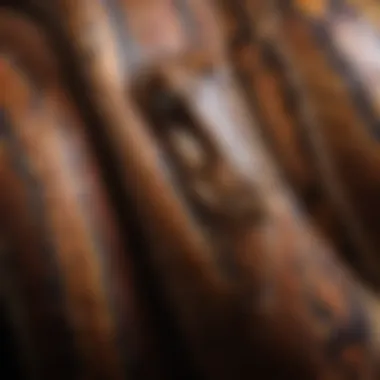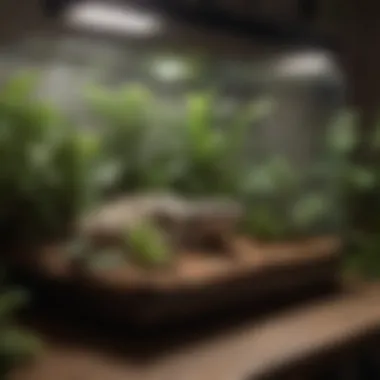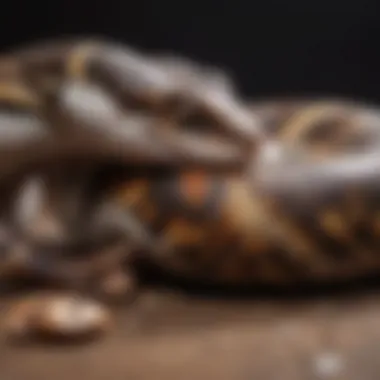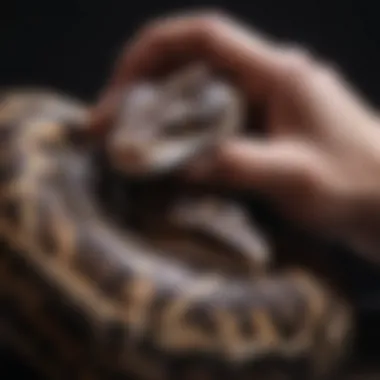Understanding Ball Pythons: A Comprehensive Guide for Pet Owners


Intro
Understanding pets goes beyond the mere idea of companionship; it presents a commitment to their care and well-being. One of the most captivating snakes for pet enthusiasts is the ball python. This article acts as a comprehensive guide, covering critical aspects of ball pythons, from their biological characteristics to their care needs.
\n## Animal Overview
Common Name and Scientific Classification
The ball python, scientifically known as Python regius, is a member of the Pythonidae family. It is often referred to as the royal python, a name derived from the historical belief that it was favored by royalty. This species is native to West and Central Africa.
Physical Characteristics
Ball pythons exhibit distinct physical traits that enhance their appeal as pets. Typically, they average between three to five feet in length, although some individuals may grow larger. They possess a robust and compact body structure. The coloration varies widely, making them attractive. Common patterns include dark brown, yellow, and cream scales.
Habitat and Distribution
In the wild, ball pythons are found in scrublands, grasslands, and forests. They prefer warm environments with adequate humidity. Since their natural habitat influences their care, understanding these needs is crucial for potential owners.
Behavior and Social Structure
Communication Methods
Ball pythons primarily use body language for communication. They may curl into a ball, especially when feeling threatened. This behavior is where their name comes from. Additionally, they use chemical signals through tongue flicking to gather environmental information.
Social Hierarchies
Unlike some reptiles, ball pythons do not have a structured social hierarchy. They are solitary creatures, coming together primarily for mating purposes. This lack of social structure simplifies their management in a home setting.
Mating and Reproductive Behavior
Breeding occurs between November and March. Male ball pythons engage in courtship, which involves a series of behavioral displays. The female lays eggs after fertilization, which she coils around for protection until they hatch. Understanding this cycle can assist owners who wish to breed their pets responsibly.
Conservation Status
Current Population Trends
Ball pythons are generally common in the pet trade. However, their wild populations face challenges due to habitat destruction. They are widely bred in captivity, helping to sustain their population numbers in the market.
Threats and Challenges
The primary threats to ball pythons include habitat loss from agricultural expansion and deforestation. Furthermore, the illegal pet trade can apply additional pressure on wild populations, highlighting the need for responsible ownership and conservation efforts.
Conservation Efforts and Success Stories
Various organizations are dedicated to the conservation of ball pythons. Captive breeding programs play a role in stabilizing their numbers while educating the public about their natural habitats. Support for these initiatives can foster a healthier population overall.
Understanding ball pythons as pets requires commitment, knowledge, and a respect for their natural behaviors and habitats.
Prolusion to Ball Pythons
Ball pythons, or Python regius, have gained significant popularity as pets in recent years. This article aims to explain the important facets of these snakes, touching on their origin, natural habitat, physical traits, and why they make suitable companions for dedicated owners. Understanding these aspects allows prospective owners to appreciate what it takes to care for these reptiles in captivity.


Origin and Natural Habitat
Ball pythons are native to West and Central Africa, predominantly found in countries like Ghana, Togo, and Benin. They typically inhabit grasslands, savannas, and areas near shrublands. These environments provide a warm climate and numerous hiding spots, which are crucial for their survival. As constrictors, ball pythons rely on their ability to ambush prey, often using their camouflage to blend into the surrounding foliage. This natural behavior is vital for their comfort in captivity, as it influences their habitat needs.
In the wild, they primarily feed on small mammals such as rodents. Understanding their natural habitat is essential for pet owners to recreate an appropriate environment that resembles their original living conditions, ensuring psychological well-being.
Physical Characteristics
Ball pythons are known for their distinctively attractive appearance. Adults can range from 3 to 5 feet in length, although some can grow larger. Their bodies are generally stout and muscular, which is characteristic of constrictor species. One key physical trait is their unique patterning and coloration; they often exhibit a blend of yellow, black, and brown hues, making each individual visually distinct.
Additionally, ball pythons have a distinct head shape with a flattened skull, designed specifically for constricting prey effectively. Their scales are smooth, contributing to their overall aesthetic appeal. As a breed, they have vast genetic variation, leading to a wide array of morphs and variations, each with differing patterns and colors.
Understanding these physical characteristics not only assists in recognizing the species but also plays a vital role in their care. Such knowledge enables pet owners to determine the right conditions, which includes humidity and temperature, that align with their biological needs.
Behavioral Traits
Understanding the behavioral traits of ball pythons is essential for any potential pet owner. Their unique characteristics can influence how these snakes adapt to captivity, their interaction with their environment, and even how they bond with their human caregivers. This section explores two key aspects: temperament and activity levels, alongside social interaction with humans.
Temperament and Activity Levels
Ball pythons are often noted for their calm and docile nature. This temperament makes them particularly appealing for new reptile owners. Typically, these snakes are less aggressive than other snake species. They tend to trigger defensive behaviors only when they feel threatened or stressed. This is a significant aspect to consider, especially in households with children or other pets.
In terms of activity levels, ball pythons do not require excessive movement. They are generally more sedentary during the day and become more active at night. This nocturnal behavior means they might be less engaging during daytime hours. However, understanding their activity cycle can help owners appreciate the unique patterns of their pet’s behavior, from exploring their habitat after dark to seeking warmth from a heat source.
It is also important to monitor their activity levels since lethargy or excessive hiding can indicate health issues. Being attentive to behavior changes is essential in ensuring a healthy and thriving pet.
Social Interaction with Humans
While ball pythons are solitary creatures in the wild, their interaction with humans can be rewarding. Over time, these snakes can become accustomed to handling, provided that it is done gently and infrequently. Many owners report their ball pythons display signs of comfort, such as relaxed body language and exploring their surroundings when held.
However, the key to positive interaction lies in recognizing their limits. Ball pythons do not crave social interaction in the way some mammals do. It is crucial to avoid excessive handling, as this can lead to stress. A good practice is to allow your ball python to acclimate to its environment before introducing handling sessions.
Essential Care Requirements
Caring for a ball python necessitates an understanding of their essential care requirements. Proper care impacts their health, behavior, and overall well-being. It establishes a stable environment where they can thrive. Identifying and implementing these requirements is crucial when keeping a ball python as a pet.
Habitat Setup
Terrarium Size and Type
The size and type of terrarium you choose significantly affect the ball python's quality of life. A minimum size of 40 gallons is recommend for an adult ball python. Larger spaces offer more room for movement and exploration. Glass, PVC, or wooden enclosures are popular choices.
Each material has its pros and cons. Glass allows visibility but is heavier and needs careful handling. PVC is lightweight, insulated, and holds humidity well. Wood can blend with the surroundings but may be challenging to maintain. Choose a terrarium that meets both aesthetic and functional needs.
Substrate Options
Selecting the right substrate can influence the comfort and health of your python. Common substrates are aspen shavings, coconut fiber, and paper towels. Aspen is excellent for burrowing but dries out quickly. Coconut fiber holds humidity, promoting hydration but can get moldy if not maintained. Paper towels are easy to clean and manage but may not look as natural. The choice of substrate affects humidity levels and ease of cleaning, crucial for ball pythons.
Heating and Lighting Needs
Ball pythons are ectothermic, meaning they rely on external heat sources for temperature regulation. Establishing a temperature gradient in the terrarium is essential. This allows your python to move between warmer and cooler areas. A basking spot should stay between 88°F to 92°F, while the cool end can be around 75°F. Use heat mats or ceramic heat emitters to maintain these temperatures. Proper heating greatly impacts digestion and overall health, so monitor the temperatures continuously.


Feeding and Diet
Prey Type and Size
Feeding your ball python with the correct type of prey is vital. Mice and rats are commonly preferred options. The size should match the python's girth; a prey item should not be wider than the snake's body. This consideration can prevent health problems. Each snake's feeding requirements might differ, and understanding them will promote healthier growth and development.
Feeding Frequency
Feeding frequency is another significant aspect. Juvenile ball pythons generally need food every five to seven days, while adults can be fed every 10 to 14 days. Regular feeding helps maintain energy levels but overfeeding leads to obesity. Adjust feeding schedules based on activity level and health status. This approach ensures that each snake is receiving the right nutrition without complications.
Hydration Needs
Ensuring access to fresh water is critical for ball pythons. They need a wide, shallow water dish to soak, which helps with hydration and shedding. Changing the water frequently minimizes bacteria growth. Proper hydration promotes healthy skin and prevents dullness. Make sure to provide clean water daily for optimal health.
Health Care
Common Health Issues
Awareness of common health issues is necessary for ball pyhton care. Respiratory infections are frequent and typically stem from improper temperature or humidity. Other issues include mites and scale rot. Recognizing signs like wheezing or changes in skin texture prompts proactive measures. Learning about potential problems aids in prevention and prompt treatment.
Routine Vet Check-ups
Regular veterinary check-ups are important. An exotic veterinarian provides thorough assessments and ensures your pet is healthy. They check for parasites, nutritional deficiencies, and overall physical condition. Routine visits can help catch health problems early. This practice can prolong your python's life and enhance its quality.
Preventative Measures
Preventative measures are key to maintaining good health. Regular cleaning of the terrarium reduces risk of diseases. Make sure temperatures and humidity levels are always in the right range. Quarantining new snakes prevents introducing diseases to existing pets. Keeping track of your snake's health habits and behaviors leads to better understanding and management of their needs.
Overall, understanding and implementing essential care requirements ensures that your ball python thrives. From habitat setup to feeding and health care, all elements play a role in promoting a healthy environment.
Behavioral Enrichment
Behavioral enrichment is vital for the overall well-being of ball pythons. While these snakes are known for their calm demeanor, providing them with an engaging environment is crucial for their mental and physical health. Enrichment helps to prevent stress, promotes natural behaviors, and can lead to a more active and healthier pet.
Importance of Hiding Spots
Hiding spots are essential components of a ball python's habitat. In the wild, these snakes often seek shelter in crevices, under rocks, or within foliage. This behavior gives them a sense of security, which is important for their overall health. An environment that offers varied hiding spots can reduce stress in captive snakes. When they have access to places where they can retreat, it mimics their natural habitat. This not only allows them to feel safe but also encourages natural burrowing and exploratory behaviors.
Key Benefits of Hiding Spots
- Stress Reduction: Providing spots to hide help in reducing stress levels. Snakes that feel exposed may exhibit signs of anxiety.
- Encouragement of Natural Behaviors: Hiding promotes behaviors like exploring and resting, which are important for their well-being.
- Temperature Regulation: Hiding spots can also aid in thermoregulation, as various materials can create different microclimates.
Potential Challenges of Ownership
Owning a ball python offers joy and companionship. However, it also includes specific challenges that potential owners must acknowledge. Understanding these challenges can lead to a more enriching experience for both the pet and the owner. By preparing for these considerations, prospective owners can minimize difficulties and enhance the long-term well-being of their snake.
Space and Financial Considerations
When deciding to bring a ball python into one's home, space and financial factors are crucial. Ball pythons require a properly sized terrarium that provides enough room for them to explore and thrive. Generally, the minimum recommended size is a 40-gallon tank for adult snakes. The tank also needs to be secure. An escape artist can easily find gaps.
In addition to the habitat, heating and lighting must be factored into the space considerations. A heating pad or lamp is essential to maintain appropriate temperatures. The cost of these setups can accumulate quickly. Owners should budget for not only the initial purchase of the tank but also ongoing expenses such as food, bedding, and utilities.


Financially, feeding a ball python can also be a recurring expense. Depending on the size of the snake, the cost of suitable prey can vary. Frozen rodents are common, and purchasing them in bulk may provide savings. However, always ensure the prey is safe and healthy for consumption.
Choosing a Ball Python
Choosing a ball python as a pet involves crucial decisions that can affect the long-term wellbeing of both the snake and its owner. Understanding the unique aspects of this species aids in making a more informed choice. Potential owners must consider several elements including health, aesthetics, and long-term care before acquiring a ball python. Knowledge of these factors ensures that both the snake's needs and the owner's capabilities align, creating a harmonious environment.
Selecting a Healthy Specimen
Trusted Sources for Purchase
Finding a trusted source for purchasing a ball python is vital. Responsible breeders, established pet stores, or reptile expos tend to be the best options. These sources often provide reptiles that have been well cared for and properly socialized. They usually offer health guarantees and can provide information about the snake's history. A key characteristic of reputable sources is transparency; they often encourage questions and visits to observe their practices.
It is essential to avoid impulse buying from dubious sellers found online or in markets. The risk associated with unknown sources includes purchasing an unhealthy snake that may have hidden health issues. Ensuring that the source maintains good husbandry practices will not only influence the initial health of your pet but will also affect your future care experience.
Signs of Good Health
Recognizing signs of good health in a ball python is a necessary skill for any prospective owner. Healthy snakes exhibit clear eyes, firm body structure, and smooth skin. Their scales should be intact without any signs of lesions or abnormalities. A healthy ball python should also show an alert demeanor, being responsive to handling, rather than lethargic or shy.
Understanding behavior patterns is an important aspect of assessing health. A ball python that is willing to explore its environment and is not excessively hidden may indicate good health. These characteristics are beneficial as they lower the chance of health complications that usually arise from poor health at the time of purchase.
Understanding Morphs and Breeds
The diversity in morphs and breeds of ball pythons can be fascinating yet overwhelming. Morphs refer to the genetic variations that result in different colors and patterns. Many enthusiasts are drawn to specific morphs. It is important for prospective owners to research varying morphs, as some may require more specialized care than others.
In understanding morphs, potential owners should seek information on breeding practices and how they affect health. Some morphs can have genetic predispositions to specific health issues. Engaging in discussions through platforms such as Reddit or visiting specialized expos may provide valuable insights. Knowledge in this area not only achieves aesthetic preferences but also ensures one is prepared for long-term care challenges.
Long-Term Commitment
Caring for a ball python is not a brief endeavor. Prospective owners must understand the long-term commitment involved in keeping these creatures. This section highlights crucial elements to consider before bringing a ball python home.
Lifespan Considerations
Ball pythons usually live between 20 to 30 years, depending on their care and environment. Owners must prepare for this substantial duration when adopting a snake. Factors such as habitat, diet, and health significantly influence their lifespan. A well-maintained snake can thrive for decades, but neglecting its needs can lead to health issues and a shorter life.
Understanding a ball python's lifespan is vital for planning. Having a pet snake means factoring in potential lifestyle changes. Whether moving to a new home, changes in family dynamics, or career shifts, these considerations affect ownership. It’s advisable to plan for a stable environment to accommodate the snake's long-term needs.
Ongoing Care and Adjustment
Maintaining a ball python requires continuous effort and adaptation over the years. Owning a snake means adjusting its habitat according to its growth. As the snake matures, its enclosure may need to expand in size. This ensures it has adequate space to engage in natural behaviors, which promotes overall well-being.
Regular assessments of heating, humidity, and substrate choice are essential to maintain a proper habitat. Changes in your household can also call for adjustments to care routines. Factors such as travel or work commitments might necessitate finding reliable care options when you are unavailable.
Additionally, as your ball python ages, its dietary needs might change. Younger snakes may need to eat more frequently compared to mature ones. Adjusting the feeding schedule can help keep them healthy. Continuously educating yourself about new findings in reptile care can provide greater insights into the best practices.
End
Recap of Key Points
- Behavioral Traits: Ball pythons are generally docile and have low activity levels, making them approachable pets. They do engage in social interaction, though they are not overly demanding of attention.
- Care Requirements: Setting up their habitat, choosing the correct diet, and addressing health care needs are paramount. Each of these factors contributes to their overall well-being.
- Behavioral Enrichment: Providing hiding spots and enrichment techniques is essential for their mental stimulation. Such measures can reduce stress and enhance their quality of life.
- Challenges of Ownership: Space requirements, financial considerations, and time commitment are all factors that prospective owners should evaluate before getting a ball python.
- Long-Term Commitment: Understanding the lifespan and the necessity for ongoing care allows owners to anticipate the responsibilities involved in long-term ownership.
Final Thoughts on Ownership
Owning a ball python can be an immensely rewarding experience, but it also comes with its set of responsibilities. It's essential for potential owners to approach this commitment with thorough understanding and preparation. Recognizing the potential challenges and benefits can lead to a healthy relationship with your pet snake.
Ball pythons can become part of the family when cared for properly. They are unique creatures that offer both beauty and fascination in their presence. Adopting one should not be an impulse decision, but rather a well-informed choice that prioritizes both the owner’s and the pet’s needs.
"A well-informed pet owner contributes to the overall health and happiness of their ball python, leading to a mutually fulfilling relationship."







